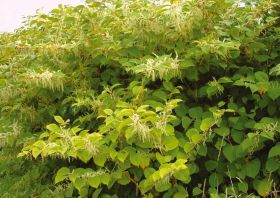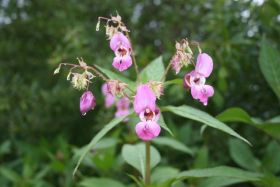One of the aims of the Biodiversity Committee of Wexford Tidy Towns is to identify areas where invasive species are present and report them so that these areas can be mapped. Knowing where these unwelcome visitors are and mapping them is the first step in their eradication. We know we have a problem in Co Wexford with Japanese Knotweed and Himalayan Balsam.
Japanese Knotweed is something you really do not want in your garden as it can really take over, even causing structural damage. Getting rid of it is not easy especially if you go about it the wrong way. Here is what the Biodiversity Ireland website says about it:
Key identification features: Japanese Knotweed is a herbaceous perennial plant with hollow bamboo-like stems that are speckled red. Grows to 3m in height. Leaves are 10-15cm long and up to 13cm wide, are shield shaped with a flat base and are arranged along zig-zag stems. Roots are bright orange inside. Flowers are very small, white, grouped and hanging. Flowering from July to October. It dies back in winter leaving dead stems. Can be confused with other non-native knotweed species.
Himalayan Balsam you can see this along water courses at various place around the county. This one also likes to take over, completely, any areas in which it takes hold.
Key identification features: Herbaceous annual plant with hollow brittle stems that are pink to red in colour in summer. It grows to 2m in height. Leaves are distinctive with finely serrated edges that can be red tinged and normally arranged in whorls of three. The flowers are ‘trumpet’ shaped and can vary in colour from white to pink to purple. It flowers from July to October. A distinctive feature is the seed capsule which explodes and ejects the seed when mature. Roots are shallow and plant is easily pulled from the ground.
We all must play our part identifying areas in which these, and other alien species, are present. Down the line we may look at organising work parties to work at clearing affected areas.
Visit the National Biodiversity Centre to learn more.
We encourage you to use this online form to report any sightings of invasive species.



